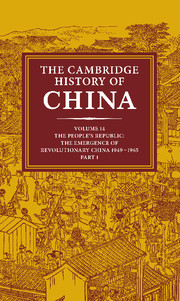Book contents
- Frontmatter
- 1 The reunification of China
- PART 1 EMULATING THE SOVIET MODEL, 1949–1957
- 2 Establishment and consolidation of the new regime
- 3 Economic recovery and the 1st Five-Year Plan
- 4 Education for the new order
- 5 The Party and the intellectuals
- 6 Foreign relations: from the Korean War to the Bandung Line
- PART II THE SEARCH FOR A CHINESE ROAD, 1958–1965
- Bibliographical Essays
- Bibliographical essays for chapters
- Bibliography
- Appendixes: Meetings and Leaders
- Conversion Tables: pinyin and Wade-Giles
- Glossary Index
- Map 1. China’s physical features
- Map 2. PRC: political (Wade–Giles romanization)
- Map 3. PRC: political (pinyin romanization)
- References
4 - Education for the new order
from PART 1 - EMULATING THE SOVIET MODEL, 1949–1957
Published online by Cambridge University Press: 28 March 2008
- Frontmatter
- 1 The reunification of China
- PART 1 EMULATING THE SOVIET MODEL, 1949–1957
- 2 Establishment and consolidation of the new regime
- 3 Economic recovery and the 1st Five-Year Plan
- 4 Education for the new order
- 5 The Party and the intellectuals
- 6 Foreign relations: from the Korean War to the Bandung Line
- PART II THE SEARCH FOR A CHINESE ROAD, 1958–1965
- Bibliographical Essays
- Bibliographical essays for chapters
- Bibliography
- Appendixes: Meetings and Leaders
- Conversion Tables: pinyin and Wade-Giles
- Glossary Index
- Map 1. China’s physical features
- Map 2. PRC: political (Wade–Giles romanization)
- Map 3. PRC: political (pinyin romanization)
- References
Summary
Three diverse traditions came together in Chinese education during the 1950s, in an uncertain combination that has yet to be fully reconciled thirty years later. The tradition that the Chinese Communist Party inherited from the Republican era was itself an amalgam of modern Western-inspired learning grafted on an ancient Confucian base. The second tradition the Chinese Communists brought with them from their own recent experience as leaders of the rural Border Region governments in the 1930s and 1940s. The third tradition was introduced into China in the 1950s, when the new Communist government embarked on an ambitious attempt to learn from the Soviet Union. The influence of each of these three traditions can still be seen in Chinese education, their outlines now firmly etched in the public mind and in official discourse by the volatile combination they have produced.
THE HERITAGE FROM THE REPUBLICAN ERA
Table 2 shows, in statistical terms, the educational system inherited from the Kuomintang government in 1949, and Table 3 presents estimates of the educational levels of the population as a whole in the same year. These national statistics obscured the diversities that existed along every conceivable dimension. The most apparent were those that are most apparent everywhere: between urban and rural, between rich and poor, between economically developed coastal areas and the more isolated hinterlands, and between men and women.
In terms of basic literacy, the male-female dimension was the least ambiguous. Women in the early decades of this century probably comprised less than the 48.5 percent of the population revealed in the 1982 census, and had an estimated literacy rate of 2 percent to 10 percent nationwide.
Keywords
- Type
- Chapter
- Information
- The Cambridge History of China , pp. 184 - 217Publisher: Cambridge University PressPrint publication year: 1987
References
- 2
- Cited by

